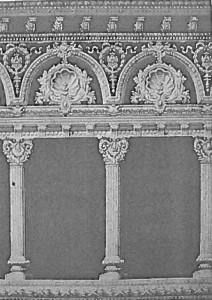This wide architectural frieze shows contains scallop shells rendered in high relief, set within arches outlined with egg and dart moldings, between which are wreath-enclosed torches. Above this is a dentil molding. This is printed in numerous shades of gray, with larger fills of complementary colors of red and green. There are also elements printed with gold mica flakes, like glitter. The glitter is used to highlight the relief of the printed architectural elements.
Wallpapers which contained mica flakes were referred to as a “flitters” or flitter friezes. Flitters seem to have been popular only for a short period around 1910. The application of mica flakes was used primarily on wide friezes but was also occasionally used on sidewall and ceiling papers. Samples of window shades in the collection also contain mica flakes. Similar applications of mica can also be found on postcards of the period, frequently those having a more romantic or personal nature.
This frieze is part of a dramatic architectural wall treatment or panel decoration that includes brackets, columns, and dentils. Shown in the illustration is a treatment which includes three different flitter friezes and a columned wallpaper, a suggestion recommended by the manufacturer in the 1907 trade publication Wall Paper News. This type of décor would be used above a chair rail or wainscot, and would probably be found in the library or study, entry foyer, or hallway.
Imperial began printing wallpaper in 1901 as Imperial Paper and Color Company. They incorporated in 1962 and operated as Imperial Wallpaper Mill, Inc. When Imperial later merged with Sunworthy Wallcoverings they became the world’s largest wallpaper company.

